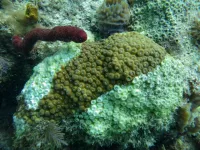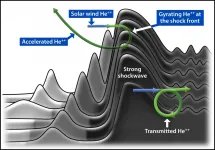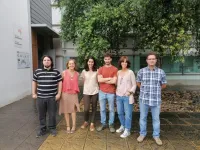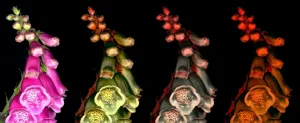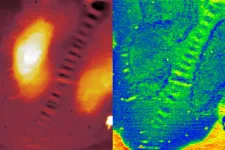Neanderthal artists? Our ancestors decorated bones over 50,000 years ago
Discovery from Unicorn Cave in Lower Saxony sheds new light on ancestors' cognitive abilities
2021-07-06
(Press-News.org) Since the discovery of the first fossil remains in the 19th century, the image of the Neanderthal has been one of a primitive hominin. People have known for a long time that Neanderthals were able to effectively fashion tools and weapons. But could they also make ornaments, jewellery or even art? A research team led by the University of Göttingen and the Lower Saxony State Office for Heritage has analysed a new find from the Unicorn Cave (Einhornhöhle) in the Harz Mountains. The researchers conclude that, in fact, Neanderthals, genetically the closest relative to modern humans, had remarkable cognitive abilities. The results of the study were published in Nature Ecology and Evolution.
Working with the Unicornu Fossile society, the scientists have been carrying out new excavations at the Unicorn Cave in the Harz Mountains since 2019. For the first time, they succeeded in uncovering well-preserved layers of cultural artefacts from the Neanderthal period in the cave's ruined entrance area. Among the preserved remains from a hunt, an inconspicuous foot bone turned out to be a sensational discovery. After removing the soil sticking to the bone, an angular pattern of six notches was revealed. "We quickly realised that these were not marks made from butchering the animal but were clearly decorative," says the excavation leader Dr Dirk Leder of the Lower Saxony State Office for Heritage. The carved notches could then be analysed with 3D microscopy at the Department of Wood Biology and Wood Products at Göttingen University.
To make a scientific comparison, the team carried out experiments with the foot bones of today's cattle. They showed that the bone probably had to be boiled first in order to carve the pattern into the softened bone surface with stone tools and the work would take about 1.5 hours. The small ancient foot bone that had been discovered was identified as coming from a giant deer (Megaloceros giganteus). "It is probably no coincidence that the Neanderthal chose the bone of an impressive animal with huge antlers for his or her carving," says Professor Antje Schwalb from the Technical University of Braunschweig, who is involved in the project.
The team of Leibniz laboratory at Kiel University dated the carved bone at over 51,000 years using radiocarbon dating technology. This is the first time that anyone has successfully directly dated an object that must have been carved by Neanderthals. Until now, a few ornamental objects from the time of the last Neanderthals in France were known. However, these finds, which are about 40,000 years old, are considered by many to be copies of pendants made by anatomically modern humans because by this time they had already spread to parts of Europe. Decorative objects and small ivory sculptures have survived from cave sites of modern humans on the Swabian Alb in Baden-Württemberg and these were found at about the same time.
"The fact that the new find from the Unicorn Cave dates from so long ago shows that Neanderthals were already able to independently produce patterns on bones and probably also communicate using symbols thousands of years before the arrival of modern humans in Europe," says project leader Professor Thomas Terberger from Göttingen University's Department for Prehistory and Early History, and the Lower Saxony State Office for Heritage. "This means that the creative talents of the Neanderthals must have developed independently. The bone from the Unicorn Cave thus represents the oldest decorated object in Lower Saxony and one of the most important finds from the Neanderthal period in Central Europe."
Lower Saxony's Minister of Science Björn Thümler says: "Lower Saxony's archaeologists are always making discoveries that rewrite the history books. Now, research in the Unicorn Cave has revealed that the Neanderthals produced elaborate designs even before the arrival of modern humans - yet another important new finding that completely revises our picture of prehistory."
INFORMATION:
In addition to the University of Göttingen, the Technical University of Braunschweig and the Lower Saxony State Office for Heritage, and the universities of Kiel and Tübingen were also involved in the project. It was funded by the Lower Saxony Ministry for Science and Culture.
Original publication: Dirk Leder, Thomas Terberger et. al. "A 51,000?year?old engraved bone reveals Neanderthals" in Nature Ecology & Evolution. DOI: 10.1038/s41559?021?01487?z
Contact:
Professor Thomas Terberger
University of Göttingen - Department for Prehistory and Early History
and Lower Saxony State Office for Heritage
Nikolausberger Weg 15, 37073 Göttingen, Germany
Tel: +49 (0)171 35 65 493
Email: Thomas.Terberger@phil.uni-goettingen.de
http://www.uni-goettingen.de/en/prof.+dr.+thomas+terberger/570533.html
Dr Dirk Leder
Lower Saxony State Office for Heritage
Scharnhorststraße 1, 30175 Hannover, Germany
Tel: +49 (0)511 92 55 303
[Attachments] See images for this press release:
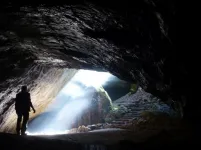
ELSE PRESS RELEASES FROM THIS DATE:
2021-07-06
Human activities like the burning of coal and fossil fuels have caused CO2 to accumulate in the atmosphere, which has significantly affected the Earth's climate. As a result, several scientists are looking for ways to convert CO2 into other valuable organic products, such as 1-butanol, which has shown promise as an alternative fuel for vehicles. This could help reduce our dependence on fossil fuels.
One method of obtaining useful compounds is by the electrochemical reduction reaction (CO2RR). Researchers have developed metal-based catalysts that can fulfill this task. However, there is a caveat: most of these catalysts are expensive and produce a variety of products during the reaction, ...
2021-07-06
MIAMI--A new study led by scientists at the University of Miami (UM) Rosenstiel School of Marine and Atmospheric Science is the first to document what coral genes are doing in response to a disease that is rapidly killing corals throughout Florida and the Caribbean. The findings can help to better understand coral immune system as new diseases emerge as the ocean warm.
The collaborative effort between researchers at the UM Rosenstiel School, Mote Marine Laboratory and the Smithsonian Marine Station is the first to document a gene expression response of corals to stony coral tissue loss disease and that the disease causes a shared immune response in at least two coral species -- mountainous star coral (O. faveolata) and great star coral ...
2021-07-06
Metal-organic frameworks (MOF) are crystalline porous organic-inorganic hybrid materials that, by filling its pores with guest molecules, can create functionalities through interactions between the organic-inorganic based frameworks of MOF (host) and its guest molecules. This host-guest chemistry has the potential to bring "designable" electrical properties, allowing for a material to be organized in ways never before possible - paving the way for the next-generation of thin-film smart devices.
"However, most MOFs exhibit poor electrical conductivity", states Professor Masahide Takahashi, ...
2021-07-06
Philadelphia and Santiago -A new study published in The Lancet Global Health showed that establishing safe nurse staffing standards in hospitals in Chile could save lives, prevent readmissions, shorten hospital stays, and reduce costs.
The study, by the Center for Health Outcomes and Policy Research (CHOPR) at the University of Pennsylvania School of Nursing, and the Universidad de los Andes - Chile School of Nursing, found very large variations in patient to nurse staffing across 40 hospitals located throughout Chile. Nurse staffing was significantly ...
2021-07-06
SAN ANTONIO -- July 6, 2021 -- Scientists have used data from the Southwest Research Institute-led Magnetospheric Multiscale (MMS) mission to explain the presence of energetic heavy elements in galactic cosmic rays (GCRs). GCRs are composed of fast-moving energetic particles, mostly hydrogen ions called protons, the lightest and most abundant elements in the universe. Scientists have long debated how trace amounts of heavy ions in GCRs are accelerated.
The supernova explosion of a dying star creates massive shockwaves that propagate through the surrounding space, accelerating ions in their path to very high energies, creating ...
2021-07-06
A research group at the University of Cordoba has conducted study focused on evaluating the potential of the Sentinel-2 sensor system's configuration to predict the amount of forage on permanent Mediterranean grasslands.
Pasture quality assessment in permanent grasslands is essential for their conservation and management, as it can facilitate real-time decision-making regarding livestock management. In this regard, the Sentinel-2 satellite constellation, launched in 2015, has proven to be a promising tool for permanent grassland monitoring. This is a sensor system developed by the European Space Agency (ESA) and that provides free and available data worldwide, with a review time of five days, and 13 spectral bands. The spectral configuration of Sentinel-2, ...
2021-07-06
Scientists from the European Molecular Biology Laboratory (EMBL) and the German Cancer Research Center (DKFZ) have presented a new method for generating metabolic profiles of individual cells. The method, which combines fluorescence microscopy and a specific form of mass spectroscopy, can analyze over a hundred metabolites and lipids from more than a thousand individual cells per hour. Researchers expect the method to better answer a variety of biomedical questions in the future.
Today, many biomedical disciplines focus their attention on the metabolites of individual cells. While in the past these were considered simply as degradation products or else building blocks for the synthesis of complex cellular molecules, ...
2021-07-06
Changes in the colour and intensity of light pollution over the past few decades result in complex and unpredictable effects on animal vision, new research shows.
Insect attraction to light is a well-known phenomenon, but artificial lighting can also have more subtle consequences for species that rely on night-time vision for their behaviour.
To explore these effects, University of Exeter researchers examined the impact of more than 20 kinds of lighting on the vision of moths, and birds that eat them.
The study found that elephant hawkmoth vision was enhanced by some types of lighting and disrupted by others, while the vision of birds ...
2021-07-06
While atomic force microscopy and scanning electron microscopy have already provided information on the morphology of bitumen surfaces in the past, for a long time it was not known whether surface and chemical composition correlate with each other. However, the chemical composition of the surface is of particular interest because oxidation processes take place there, triggered by oxygen-containing molecules in the air such as ozone, nitrogen oxides or hydroxyl radicals. The oxidation process accelerates the aging of the material - the bitumen becomes porous and damage develops.
The materials ...
2021-07-06
Metals with similar chemical properties are usually extracted together, which limits the opportunities to separate high-purity metals. To increase those opportunities, it's important to understand how different metal species act during the solvent extraction process.
Researchers from the Institute of Process Engineering (IPE), of the Chinese Academy of Sciences, have developed a new strategy to characterise polymeric transition metal species in acidic solution, which may help to separate those high-purity metals.
Their study, which was published in the KeAi journal Green Chemical Engineering (GreenChE) employed a high-resolution electrospray ionization ...
LAST 30 PRESS RELEASES:
[Press-News.org] Neanderthal artists? Our ancestors decorated bones over 50,000 years ago
Discovery from Unicorn Cave in Lower Saxony sheds new light on ancestors' cognitive abilities


